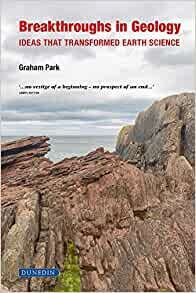By Graham Park

In recent years, Graham Park has been prolific in his writing for Dunedin Academic Press and some of his other books are reviewed on this website (see, for instance, Introducing Geology, Introducing Natural Resources, Introducing Tectonics, Rock Structures and Mountain Belts and The Making of Europe: A geological history). In this new tome, he has produced what I suspect is a really great introduction to a range of key concepts and geological processes for both undergraduates and the interested, moderately well-informed amateur.
The premise of Breakthroughs in Geology is that geological research does not follow a smooth progression of small incremental advances, but, much as the American philosopher Thomas Kuhn proposed in 1962 in connection with shifts in scientific ‘paradigms’, but rather consists of a series of significant discoveries and sometimes revolutions (for example, plate tectonics) in interpretation that transformed geologists’ understanding of the earth. And each of these changes or new ideas has encouraged a burst of research attempting to apply them more widely to test their general application and validity.
These ‘transformative’ ideas (the most well known of which I have already referred to – plate tectonics – was questioned and, indeed, rejected, when it was first suggested) are now universally accepted as an overarching principle, like Darwinian evolution is for biology or quantum physics and relativity are for physics. In fact, huge numbers of subsequent advances in geology have been based on these transformative breakthroughs.
Each of the book’s 12 chapters covers a one such transformative idea, which is discussed in its historical context, together with insights into the relevant scientists (including some of the less well appreciated contributions). The topics covered include, Uniformitarianism, evolution, continental drift, hot spots, plumes, back arc basins and Ophiolites, along with the somewhat more arcane sequence stratigraphy and the Strain Ellipsoid.
The 12 topics are not exhaustive (how could they be in a book of this type?) and the author claims that he is biased in his choices, being a structural geologists. However, while I struggled a bit to understand some of the ideas, on the whole, the effort was worthwhile and the clarity of his writing made it a fascinating read. In addition, there is a glossary of technical terms and key reading lists for each chapter. And, as is the case for all Dunedin books, this one contains full colour photographs and diagrams, making it a great and essential addition to any university library or indeed the personal collection of any interested amateur.
Breakthroughs in Geology: Ideas that transformed Earth Science, by Graham Park, Dunedin, Edinburgh and London (2019), 262 pages (hardback and also available as an ebook), ISBN:978-1-780-46076-5


